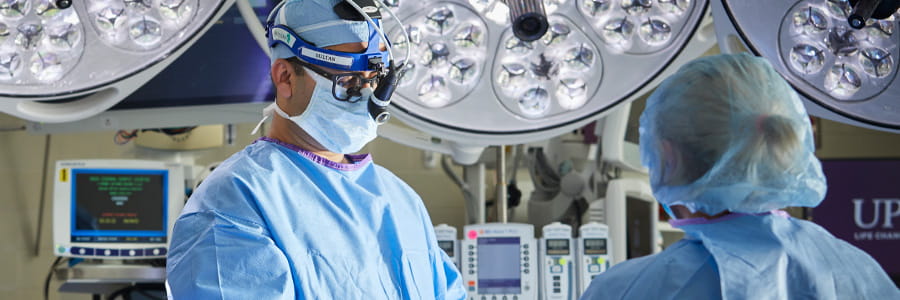Aortic Clinical Trials
PI: Ibrahim Sultan, MD
Research Coordinator: Missy Sanders Linger
To purpose of this study is to collect data on short and long-term outcomes of the MITRIS RESILIA mitral valve in subjects requiring replacement of their native (original) or prosthetic (artificial) mitral valve.
The PROGRESS Trial - A Prospective, Randomized, Controlled Trial to Assess the Management of Moderate Aortic Stenosis by Clinical Surveillance or Transcatheter Aortic Valve Replacement
PI: Ibrahim Sultan, MD
Research Coordinator: Kristin Konopka
This study is being done to see if the SAPIEN 3™ and SAPIEN 3 Ultra™ Transcatheter Heart Valve is beneficial for patients with moderate, calcific aortic stenosis. You will be randomly assigned to one of two groups. You will have an equal chance of getting into either group (like flipping a coin):
- Treatment Group: If you are assigned to this group, you will have a procedure to replace your aortic valve with the Edwards SAPIEN 3 or Edwards SAPIEN 3 Ultra system. The type of procedure for this device is called Transcatheter Aortic Valve Replacement (TAVR).
- Clinical Surveillance Group: If you are assigned to this group, you will not have your heart valve replaced. However, your doctor will continue to provide optimal medical therapy and will closely monitor how you are doing (this is called ‘Clinical Surveillance’).
PRO: Optimize Pro FX TAVR Post Market Study
PI: Dustin Kliner, MD
Research Coordinator: Stephanie Shearer
The purpose of this study is to learn more about how well this device works and to learn about the effects of following a particular set of steps when treating a patient with the EvolutFX system.
TiGER-001 Study
PI: Ibrahim Sultan, MD
Research Coordinator: Kristin Konopka
Terumo Aortic manufactures endovascular (inside the blood vessel) grafts that are widely used to treat a number of different conditions. Terumo Aortic is funding the TiGER study to better understand how the study devices perform. You are being asked to take part because your doctor has decided that the most appropriate treatment for your condition is with a Terumo Aortic Relay®Pro Endovascular graft.
Terumo Aortic/Thoraflex Hybrid and Relay Extension Post-Approval Study (EXTEND)
PI: Ibrahim Sultan, MD
Research Coordinator: Kristin Konopka
The purpose of this study is to gather further information on the use of the Thoraflex Hybrid study device alone and in combination with the RelayPro NBS Stent-graft to treat aortic disease.
PMCF Mitral Registry
PI: Johannes Bonatti, MD
Research Coordinator: Gail Wallen
The purpose of this registry is to collect information about the safety and performance of market-released heart valve repair and replacement products made by Medtronic.
Valved Graft Post-Market Clinical Follow-up Study
PI: Derek Serna-Gallegos
Research Coordinator: Gail Wallen
The purpose of this study is to evaluate the safety and effectiveness of Abbott Valved Graft devices used for surgical replacement for patients with a malfunctioning native or prosthetic aortic heart valve and ascending aorta pathology.
GORE® EXCLUDER® Thoracoabdominal Branch Endoprosthesis
PI: Michael Singh, MD
Research Coordinators: Judith Brimmeier, 412-623-8486 | Julia Wozniak, 412-623-8443
A study of patients with aortic aneurysm involving the visceral vessels requiring treatment defined as:
- Fusiform aneurysm diameter ≥ 5cm.
- Saccular aneurysm.
- Rapid aneurysm growth.
Must also have proper aortic anatomy to receive the TAMBE device.
This prospective, non-randomized, multi-center study has two independent arms:
- TAAA requiring only TAMBE system.
- TAAA requiring TAMBE system and CTAG device(s).
The study is to assess the safety and effectiveness of the TAMBE device in treating thoracoabdominal and pararenal aortic aneurysms.
GORE® TAG® Thoracic Branch Endoprosthesis
PI: Michael Singh, MD
Research Coordinators: Judith Brimmeier, 412-623-8486 | Julia Wozniak, 412-623-8443
A study of patients > 18 years of age with thoracic aortic lesions which require coverage of the left subclavian artery, left common carotid artery and/or the brachiocephalic trunk/innominate artery for effective treatment and have anatomy suitable for treatment with the TAG TBE device. The prospective, non-randomized study will assess the GORE® TAG® Thoracic Branch Endoprosthesis (TBE Device) treating lesions of the aortic arch and the descending thoracic aorta.




















